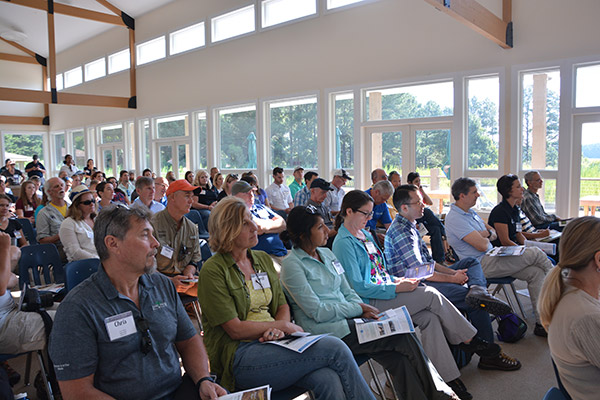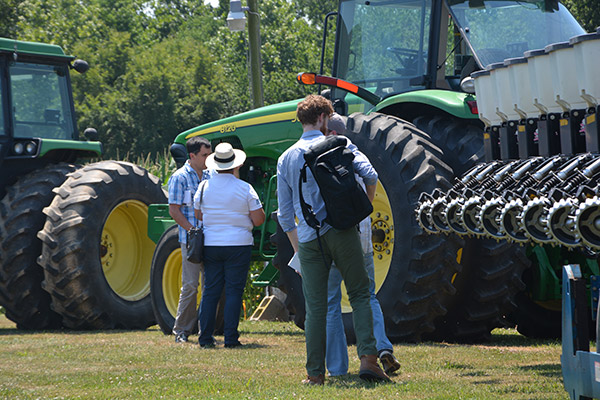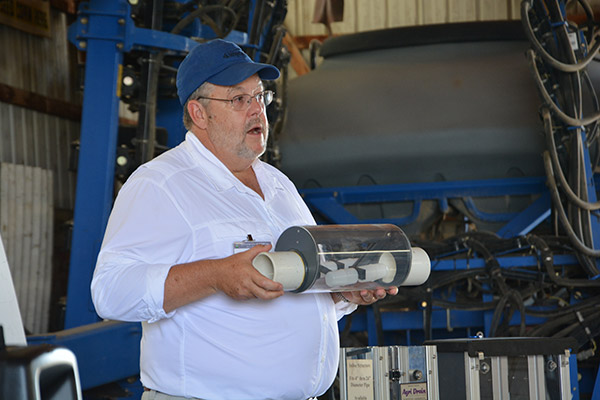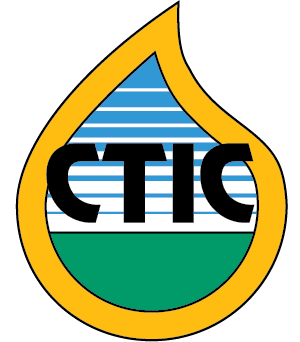

CTIC Conservation in Action Tour Draws 130+ to Chesapeake Bay
About 130 farmers, agency staffers, soil and water conservation district personnel, environmental and agribusiness leaders, and others gathered on the shores of the Chesapeake Bay for CTIC’s “Bringing Back the Bay” Conservation in Action Tour July 10 and 11.
The Chesapeake Bay has become the proving ground for a wide range of best management practices (BMPs) designed to protect the fragile system from excess nutrients and sediments flowing in from a 64,000-square-mile watershed that reaches all the way into New York State. Area farmers have become experts in managing nutrients at every level, from applying manure and commercial fertilizer to minimizing runoff from their fields.
In addition to perspectives on innovative practices from a range of crop, dairy and poultry producers, Conservation in Action Tour participants heard from Hoopers Island Oyster Company co-founder Johnny Shockley and Oyster Recovery Partnership fisheries scientist Julie Reichert-Nguyen. The shellfish experts described not only how agricultural practices impact oyster fisheries in the Bay, but also how oysters play a role in reducing nutrient levels in the system and could be managed in conjunction with other water-protecting BMPs. Agricultural advisor Kelly Shenk of U.S. EPA tied together the broad spectrum of stakeholders in the Chesapeake Bay watershed.
Chip and Jason Councell—the 10th and 11th generation on their family farm on Maryland’s Eastern Shore—shared their conservation ethic as well as their consumer-focused marketing program, while Bobby and Kyle Hutchison demonstrated how they live up to the sign in their office that reads, “Maryland Farmers Protect the Bay Every Day” on their diversified grain and vegetable operation.
Even the relatively new site of the tour dinner, the 2015-vintage Triple Creek Winery, is rooted in five generations of local farming by the Spies family. With deep roots in the community and the eyes of Washington—and the world—focused on the Bay’s recovery, the farmers and fishermen of Maryland’s Eastern Shore are pushing conservation into a new era. Next year’s Conservation in Action Tour—CTIC’s 12th annual—will be held in the Des Moines area. Watch www.ctic.org/CIATours for details so you can mark your calendar and join us!

Conservation in Action Tour participants fill the Chesapeake Bay Environmental Center.
|

Conservation in Action Tours provide a close-up look at BMPs.
|

Alex Echols of Ecosystem Services Exchange describes controlled drainage management systems.
|
OpTIS Land Use Data Pilot Nears Release
For decades, CTIC distributed the CRM Survey, data on conservation practices that had been gathered by hundreds of conservationists in painstaking transect surveys. Today, CTIC, Applied GeoSolutions (AGS) and The Nature Conservancy are collaborating on a new effort to take crop residue and cover crop surveys into the space age, using data gathered by multiple satellites and processed through AGS's validated calculations.
The Operational Tillage Informational System (OpTIS) produces accurate, timely maps of crop emergence, crop residue and winter cover crops using publicly available satellite data. Data are aggregated to county or watershed resolution to protect the privacy of individual farmers.
OpTIS data can be helpful to many users, including:
- Soil and water conservation districts establishing program priorities and evaluating progress in achieving conservation goals.
- Federal and state agencies comparing the effectiveness of conservation programs across large regions.
- The agri-food supply chain developing environmentally sustainable sourcing programs.
- Environmental groups focusing efforts to improve soil health and water quality.
- Academic researchers studying the impacts of conservation practices on soil health or water quality.

Remote sensing provides data on conservation practices through the new OpTIS project.
"We know that improving soil health on America's farmland can significantly improve our water quality, store more carbon, and help farmers sustainably produce more food," said Pipa Elias, soil health strategy lead for The Nature Conservancy. "OpTIS is an important, innovative technology that will empower an array of stakeholders, including conservation organizations, with the information they need to efficiently provide farmers with the tools they need to adopt proven soil health practices."
AGS and CTIC conducted a pilot project to test, ground-truth and document the capabilities of OpTIS using remote sensing data and archived land use information across the state of Indiana. These Indiana data, covering 2005 through 2015, will be available on CTIC's new website, which is due to launch soon.
Phase 1 data, covering the entire U.S. Corn Belt from 2005 to 2017, will be available through a simple, flexible interface on the CTIC website by April 2019. Phase 2, covering all U.S. counties with more than 5,000 acres of row crops, is targeted for release in 2021.
Watch www.ctic.org for the release of OpTIS data. For more information, contact Dave Gustafson at CTIC.
Supply Chain Sustainability Project Trains Crop Advisors and Ag Retailers
CTIC's ongoing sustainable supply chain project in Iowa has shifted to engage local retail agronomists, certified crop advisors (CCAs) and individual farmers to advise and advocate for the adoption of critical conservation systems identified in the Iowa Nutrient Reduction Strategy.
The first four years of the project, which included agronomic consultation and cost-share funding for farmers, helped producers in six critical watersheds plant nearly 40,000 acres of cover crops. A three-year extension funded by the Iowa Department of Agriculture and Land Stewardship (IDALS) allows the effort to now shift to building capacity among trusted crop advisors in the Skunk River watershed.
Technical assistance is key to success with cover crops, notes CTIC project director Mike Smith.
"Those relationships will be enhanced by a training and incentive program," Smith adds. CTIC is working with Practical Farmers of Iowa and The Nature Conservancy to deliver technical assistance to advisors and retailers.
Understanding advisor awareness, attitudes and behaviors will be vital to ensuring that farmers get the support they need in adopting such important conservation practices. For more information, contact Mike Smith at CTIC.

Food companies want to source sustainably produced crops. CTIC is helping create those supply lines.
CTIC's "Let's Do The Math On Cover Crops" Makes Headlines
CTIC's far-reaching Economic, Agronomic and Environmental Benefits of Cover Crops project - commonly called "Let's Do The Math on Cover Crops" - is in the final stage of pulling together data on the impact of cover crops on honey bee habitat. With data from The Ohio State University, CTIC will soon provide insight into cost-effective opportunities to provide pollinator forage on agricultural landscapes.
|
In the meantime, the project's outreach effort got a huge boost this season from long-time CTIC partners at Penton/Farm Progress. Kurt Lawson, editor in chief of Corn and Soybean Digest, worked with our team to source several articles on cooperators in the program. Among the CTIC-penned articles that ran in this top publication were:
The "Let's Do The Math" project has also provided valuable insight into researching multi-variate topics, notes project manager Mike Smith at CTIC.
|

Data from the “Let’s Do The Math On Cover Crops” project is providing insight into providing pollinator forage on agricultural landscapes.
|
"What we learned through this project has already been put to use," Smith says. "Purdue's Ag Economics Department developed an improved data collection framework intended to increase the accuracy of ongoing research into cover crop economics. The experience also enabled CTIC to serve as a consultant for the design and management of the Honey Bee Health Coalition's Bee Integrated Demonstration Project."
Next CTIC Board Meeting: November 7
CTIC's board of directors will meet in Baltimore on November 7, 2018; members are welcome to attend. Watch www.ctic.org for details.
Dave Gustafson Steps In As Interim Executive Director
|
With the departure of chad Watts, former CTIC board member Dave Gustafson has spent the past few months supporting the organization as interim executive director. Helping guide the day-to-day operations of the office as well as the strategic direction of the organization, Dave and the board have provided steady leadership as CTIC positions itself for even greater impact.
With a PhD in chemical engineering and three decades of experience as an environmental scientist in the crop protection industry - including tenure at Monsanto, which he represented on CTIC's board - Dave has also served on various governmental and civil society efforts focused on conservation and sustainability issues. His current independent research focuses on using modeling to help food systems meet human nutrition needs in more sustainable ways.
|

Dave Gustafson, former CTIC board member, is serving as interim executive director.
|
Dave is leading the CTIC Board in a search for a full-time executive director. Contact him with leads or ideas.

CTIC brings people together to share insight and data on agricultural conservation.
Renew Your CTIC Membership ...Or Join!
With the conservation title of the next farm bill in the works, farmers finding ways to use conservation practices to cut costs, and consumer pressure on for growers to farm sustainable, CTIC is at the leading edge of a wide range of hot topics. This is a perfect time for you and your company/organization to get involved.
CTIC members receive:
- Access to research and information on conservation agriculture
- National recognition for supporting agricultural conservation
- Networking opportunities unparalleled in agriculture or conservation
- Opportunities to participate in research and demonstrations of conservation practices
- Interaction with technical professionals and policymakers
Your membership helps CTIC connect, inform, and champion - and it puts you at the table with the most diverse and dedicated group of conservation agriculture proponents in the country.
Contact Crystal Hatfield for details on how to join or renew.
 |
Conservation Technology Information Center 3495 Kent Avenue Suite L100 West Lafayette, IN 47906 765.494.9555 ctic@ctic.org www.ctic.org |